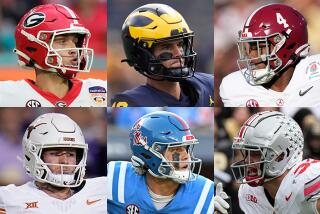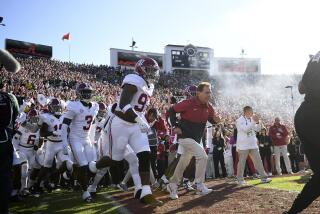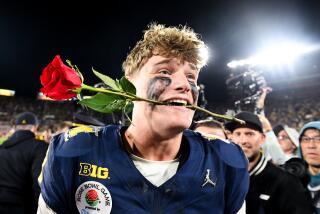His Profit Is Postmortem
Once again, Neil Gilman will scour the sports section this morning, eagerly turning the pages in search of schools that won big football games. Then he’ll place a call to their athletic departments.
It won’t necessarily be a congratulatory call. It will be strictly business.
Gilman is president of Gilman Gear, the nation’s largest manufacturer of goal posts. He loves to read stories or see TV highlights of goal posts getting ripped down. Then he goes and builds them back up.
Business has been brisk this season for Gilman -- he has received at least nine midseason orders and might be getting more after Oklahoma State fans destroyed the goal posts Saturday after a 38-28 victory over Oklahoma.
“It’s become the fashionable thing to do,” Gilman said.
The recent rash of ripped-down posts at colleges across the country has the Gilman, Conn., company closing in on a sales record of 16 sold during the 2000 season.
Fans have shown little remorse for the safety of fellow revelers, much less the cost of replacing goal posts, to the dismay of athletic department officials.
After Utah defeated Brigham Young on Nov. 23, Utes fans stormed the field, tore down the aluminum goal posts and carried them to the top of Rice-Eccles Stadium, redefining the concept of a costly victory.
“You’re looking at spending $5,800 because a couple of students thought it’d be funny to take them down,” Utah event and facilities coordinator Steve Pyne told Bloomberg News.
Utah isn’t the only place where people have been downright rude to the uprights.
Thousands of Iowa fans stormed the field after the Hawkeyes defeated Minnesota, tearing down one of the goal posts and parading around the Metrodome with it for a couple of victory laps. They then broke the post into smaller, easier-to-manage pieces so they could carry the remnants up the stairs and out of the dome.
Locally, the posts are rarely bothered by UCLA or USC fans.
In 1999, when USC beat UCLA to end an eight-game losing streak to the Bruins, some fans rushed the field and a few had confrontations with police. The same thing occurred last season, when USC ripped the Bruins, 27-0.
But the goal posts are usually spared, as they were Saturday after the Trojans’ 44-13 victory over Notre Dame.
“Trojan fans are pretty mellow,” said John Henderson, USC assistant athletic director in charge of operations and game management. “But a lot of fans have been mellow across the country until this year and it’s created a problem. The alcohol pregame and during the game contributes to a lot of it.”
Gilman’s company makes goal posts for about 9,000 high schools, 900 colleges and most NFL teams. The top-of-the-line goal post, a 30-foot aluminum model, costs $5,600 and is used by NFL teams and many major colleges. A less-expensive 20-foot model, used by high schools and some colleges, costs $4,600.
Gilman’s goal posts are made to withstand wind and weather, but not a mob of crazed fans, so about 20 schools have switched from aluminum to steel goal posts designed to withstand rowdy fans.
After Ohio State beat Michigan on Nov. 23 in Columbus to secure a spot in the national championship game, fans stormed the field but were unable to rip down the steel posts.
“We choose to pay for safety,” said Don Patko, assistant athletic director for facilities at Ohio State. “The decision has worked out for us.”
The steel posts aren’t indestructible, but they can buy security an extra 30 minutes to get fans off the posts before they start to fall.
At $30,000, the steel posts cost as much as six times as much as the aluminum ones, but it doesn’t stem their popularity -- they are installed at several other Big Ten schools and at Notre Dame, Stanford and Arizona State.
Schools are striking back in other ways, figuring out how to regain money spent on new goal posts ... and then some.
Take North Carolina State, which lost a post after a 17-7 victory over Florida State on Nov. 23, but will gain economically by selling 175 one-foot pieces of the posts.
The Wolfpack finished the regular season with a 10-3 record. The cost of each piece: $103.
*
Times of Turmoil
Used to be that the winner of the Florida State-Florida game was one step closer to a national title.
Now the winner is simply known as the Turmoil Bowl champion.
The teams met Saturday with seven combined losses, two coaches feeling the heat and a host of touchy quarterback issues. Not to mention that neither team was ranked in the top 10 for this game for the first time since 1986.
On one hand, there was besieged first-year Florida Coach Ron Zook, who had lost home games to Miami and LSU by a combined 54 points and had been blamed for Rex Grossman’s fall from Heisman Trophy candidate to forgotten quarterback.
Things weren’t much better in Tallahassee, where the Seminoles were far from the team that started the season ranked No. 3 in the Associated Press poll. More recently, the Seminoles were jolted by last week’s dismissal of quarterback Adrian McPherson, arrested on charges of stealing a blank check and receiving nearly $3,500 after it was cashed.
The Seminoles can call themselves the titans of turmoil: They defeated Florida, 31-14.
*
Not OK in Oklahoma
Oklahoma Coach Bob Stoops seemed obsessed with cutting down Oklahoma State after the Sooners’ loss last season to their in-state rival cost them a shot at the national championship. On two occasions, Stoops made light of programs that were “satisfied with four wins,” a shot at Oklahoma State’s 4-7 record last season.
Fast forward to Saturday.
Oklahoma State led the Sooners, 31-6, on the way to a 38-28 victory that wiped out what was left of Oklahoma’s national title hopes. Again.
Stoops seemed remorseful this time, after Oklahoma State rolled up 506 yards.
“There are no excuses,” he said. “They did an excellent job all around -- their coaches and players -- and just beat us.”
*
Backyard Fun
There’s a reason it doesn’t have a cute name like the Apple Cup or the Old Oaken Bucket game.
The annual game between Pittsburgh and West Virginia is called the Backyard Brawl with good reason. A short bus ride through hilly, sparsely populated countryside separates two schools that have turned the perception of cultural differences into a lively rivalry.
Pittsburgh represents big-city elitism in the eyes of Mountaineer fans, while Pittsburgh fans feel West Virginians are a bunch of people biding their time until the start of hunting season.
This year’s meeting, the 95th between the teams, was particularly important because both brawlers were ranked going into the game for the first time since 1989.
Score one for the hunters: West Virginia defeated Pittsburgh, 28-21.
“Winning this is [big] because it means we’re 9-3 and going to a bowl -- and Pitt always is the team we want to beat,” said West Virginia running back Quincy Wilson.
*
Times staff writer Rob Fernas contributed to this report.
More to Read
Go beyond the scoreboard
Get the latest on L.A.'s teams in the daily Sports Report newsletter.
You may occasionally receive promotional content from the Los Angeles Times.











